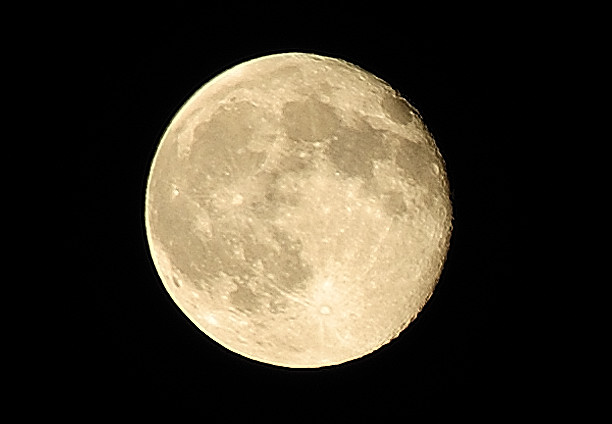Over the winter break my family and I flew down to San Diego to bathe in the sun’s rays. On the flight, down a few hours past sunset, I realized the half moon that was rising into the sky didn’t look right. Instead of the familiar vertical shadow separating the light side of the moon from the dark, the shadow was more horizontal, making it look like the bottom half of an orange. But white, and bright. And two dimensional. Okay maybe it wasn’t the best metaphor. It looked like a salad bowl from a side view? A protractor, curved side down? A semicircle? Whatever, I’m a physics student, not an English one.
We arrived in LAX, got our rental car, and began the two hour drive down to San Diego around 11:00 p.m.; because I was bored and still relatively awake I decided to figure out why the moon looked all weird and sideways.
Our solar system is pretty much in a flat plane, with planets, moons, and asteroids all roughly sitting in a big disk rotating in the same direction around the sun. The moon was half full, so if I were standing on top of the Earth looking at the sun, the moon would be off to my side. And from my standpoint on top of the Earth, the moon’s shadow would be vertical, not horizontal.
I look out of the sedan’s windows. The moon was still definitely a salad bowl.
Wait. If being on top of the world means that the half moon’s shadow will be vertical, then if I were to walk down to the middle of the Earth (relative to the plane of the solar system, not necessarily the equator — we’ll call this the “solar middle”) then my perspective would shift 90 degrees and so the moon would be horizontal.
But then our current location didn’t make any sense. We were pretty far from the equator, and not only that, but it was winter; we should be tilted away from the sun, putting us closer to the “top” of the Earth, not vice versa. I looked out the window at the half moon. What was going on?
I stopped my current train of thought. The observations must be right. If observation doesn’t agree with theory then it’s time to rethink the theory. Winter would mean that our position would be shifted towards the top of the Earth during the daytime, sure. But that means at night we would swing as close to the solar middle of the Earth as ever. And it was indeed nighttime.
I started filling in my family on my thoughts as I went, trying to keep my dad alert and awake as he drove.
Well, I thought, for the moon to be horizontal, we need to be exactly on the solar middle. One way to get there would be to stand on the tropic of Cancer, in the middle of the night, on the winter solstice, so that instead of having the sun directly overhead, the moon would be up and completely horizontal. Almost as an afterthought, I realize that because each degree latitude is a degree shift in perspective relative to the solar plane, for each degree of latitude above the tropic of Cancer, the moon would be angled exactly one degree above horizontal. Now here’s the thing: I really like mathematical abstractions. But what I like more is when these abstractions become something real. In the passenger seat of the car, half an hour past midnight, I started getting really excited. “It is the middle of the night,” I blurted out. “It is the winter solstice. The moon is 12 degrees above the horizontal. We can calculate our latitude just by using the angle of the shadow across the moon!” Now I’m no master of star charts, but I am a big fan of unconventional physics, so I was pumped. We remembered the tropic of Cancer to be about 22 degrees, so we add the about 12 degrees for the moon’s slope, and we get an answer. We’re at 34°N.
My dad then jumps in and does his own estimation (and he is a master of estimation); he knows that originally, Canada had a claim for all land on the west coast down to the 45th parallel. Well, he uses that knowledge and extrapolates a bit to guess that we’re at a latitude of 35°N. Both of our estimations are using kind of haphazard methods — but they line up almost perfectly. I start freaking out a little.
I break out my mom’s phone (which has data), to look up the actual latitude of San Diego. My hands are shaking; I’m super nervous all of a sudden. I really want this to work. I peek at the phone, and it tells me San Diego is at 32.7°N. I’m not ecstatic, but we did pretty good. I tell my dad, and he responds by telling me that we’re not in San Diego yet. We’re still in Irvine, over an hour to San Diego. I look up Irvine. It’s at 33.7°N. My calculation was 34°N. I was stunned. I had managed to figure out our latitude by looking at the shadow that fell across the half moon at the dead of night on the winter solstice just by thinking long and hard — and I was out by three tenths of a degree!
Later I realized that we had gotten the tropic of Cancer wrong; it’s at roughly 23.5°N so we would have been out by about 2°, but our estimate for the moon’s angle wasn’t meant to be super precise. I guess the life lesson here is to never underestimate the power of a bit of applied knowledge and some mental math. And, of course, to always carry a protractor.


